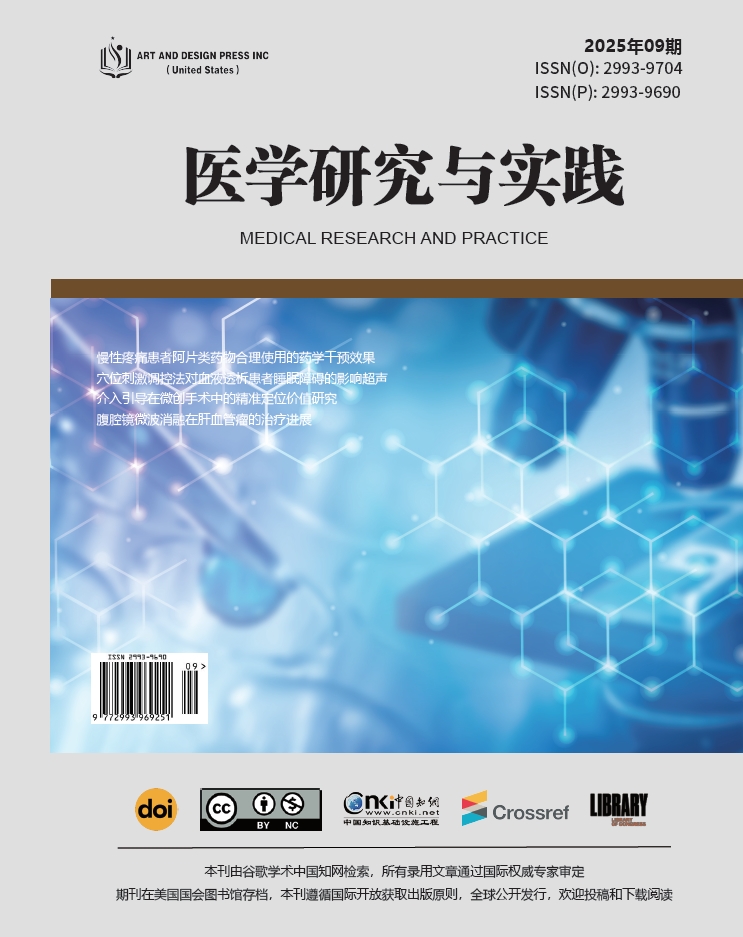Volume 3,Issue 9
Fall 2025
胃癌化疗引起的骨髓抑制及其预测模型
骨髓抑制是胃癌化疗过程中常见且严重的副作用之一。建立有效的风险预测模型有助于早期识别高危患者,指导临床干预,并改善治疗预后。本文综述了胃癌化疗后骨髓抑制的主要危险因素,评估了现有预测模型的临床应用效果,并对不同模型的优缺点进行了比较。同时,本文还分析了当前研究中的局限性,并展望了未来的研究方向,旨在为个体化防治策略的制定提供参考依据。
[1] Bray F, Laversanne M, Sung H, et al. Global cancer statistics 2022: GLOBOCAN estimates of incidence and mortality worldwide for 36 cancers in 185 countries[J]. CA: a cancer journal for clinicians, 2024, 74(3): 229-263.
[2]高鸿超,彭智.晚期胃癌的综合治疗进展[J].中国肿瘤临床,2024,51(17):896-901.
[3]秦叔逵,马军.中国临床肿瘤学会(CSCO)肿瘤放化疗相关中性粒细胞减少症规范化管理指南(2021)[J].临床肿瘤学杂志,2021,26(7):638-648.
[4]黄新娟,李旭英,谌永毅,等.肿瘤患者化疗后骨髓抑制发生风险预测模型的研究进展[J].肿瘤药学,2024,14(3):327-331.
[5]叶勇,翁金森,林艳,等.恶性肿瘤患者化疗后发生骨髓抑制的影响因素[J].医学新知杂志,2019,29(5):560-561.
[6]李茁钰,刘凯,张维汉,等.全球及中国胃癌的流行病学特点及趋势:2018–2022《全球癌症统计报告》解读[J].中国普外基础与临床杂志, 2024, 31(10):1236-1245.
[7]袁芳润,王新新.非小细胞肺癌首次化疗患者骨髓抑制发生情况及其危险因素分析[J].反射疗法与康复医学,2024,5(21):117-120.
[8] Que W C, Huang Y F, Lin X Y, et al. Paclitaxel, 5-fluorouracil, and leucovorin combination chemotherapy as first-line treatment in patients with advanced gastric cancer[J]. Anti-Cancer Drugs, 2019, 30(3): 302-307.
[9] Bian Y, Xie F, Han J, et al. Nutritional evaluation study based on NRS 2002, OPNI, and their combined use in patients with adverse drug reactions after chemotherapy: a cross-sectional study[J]. Annals of Translational Medicine, 2022, 10(4): 180.
[10] Lavery L, DiSogra K, Lea J, et al. Risk factors associated with palbociclib-induced neutropenia in patients with metastatic breast cancer[J]. Supportive Care in Cancer:Official Journal of the Multinational Association of Supportive Care in Cancer, 2022, 30(12): 9803-9809.
[11] Du Y, Liu Y, Fang R, et al. Risk Prediction of Myelosuppression Following First-line Chemotherapy in Colorectal Cancer[J]. Journal of Cancer, 2025, 16(4): 1379-1396.
[12] Chen W Q, Peng L, Zeng X L, et al. Predictors of Myelosuppression for Patients with Head and Neck Squamous Cell Carcinoma After Induction Chemotherapy[J]. Clinical Medicine Insights. Oncology, 2024, 18: 11795549231219497.
[13] Ouyang W, Liu Y, Deng D, et al. The change in peripheral blood monocyte count: A predictor to make the management of chemotherapy-induced neutropenia[J]. Journal of Cancer Research and Therapeutics, 2018, 14(Supplement): S565-S570.
[14] Zhang Q, Qian Y, Yin Y. Comparison of S-1-based vs. capecitabine-based adjuvant chemotherapy for patients with gastric cancer: a systematic review and metaanalysis[J]. European Journal of Clinical Pharmacology, 2021, 77(12): 1791-1804.
[15] Rha S Y, Oh D Y, Yañez P, et al. Pembrolizumab plus chemotherapy versus placebo plus chemotherapy for HER2-negative advanced gastric cancer (KEYNOTE-859): amulticentre, randomised, double-blind, phase 3 trial[J]. The Lancet. Oncology, 2023, 24(11): 1181-1195.
[16] Wang R, Li M, Zheng Y, et al. Clinical effects of neoadjuvant chemoradiotherapy versus neoadjuvant chemotherapy on complications and recurrence in patients with advanced gastric cancer[J]. Pakistan Journal of Medical Sciences, 2024, 40(7): 1556-1560.
[17] Wang J J, Shao H, Zhang L, et al. Preoperative chemoradiation-induced hematological toxicity and related vertebral dosimetry evaluations in patients with locally advanced gastric cancer: data from a phase III clinical trial[J]. Radiation Oncology (London, England), 2023, 18(1): 100.
[18] Ravegnini G, Fosso B, Saverio V D, et al. Gastric Adenocarcinomas and Signet-Ring Cell Carcinoma: Unraveling Gastric Cancer Complexity through Microbiome Analysis-Deepening Heterogeneity for a Personalized Therapy[J]. International Journal of Molecular Sciences, 2020, 21(24): 9735.
[19] 余旭睿. 非小细胞肺癌化疗患者发生骨髓抑制的影响因素[J].中国民康医学,2024,36(3):19-21, 25.
[20] Barbosa-Martins J, Marques S, Miranda O, et al. Gastric Cancer With Multiple Bone Metastases: An Uncommon Primary Presentation[J]. Cureus, 2022, 14(9): e29467.
[21] Lyman G H, Kuderer N M, Crawford J, et al. Predicting individual risk of neutropenic complications in patients receiving cancer chemotherapy[J]. Cancer, 2011, 117(9):1917-1927.
[22] Venäläinen M S, Heervä E, Hirvonen O, et al. Improved risk prediction of chemotherapy-induced neutropenia-model development and validation with real-world data[J].Cancer Medicine, 2022, 11(3): 654-663.
[23] Zhou S, Song B, Li C, et al. The predictive model for risk of chemotherapy-induced thrombocytopenia based on antineoplastic drugs for solid tumors in eastern China[J].Scientific Reports, 2023, 13(1): 3185.
[24]Lu Y, Zhang Q, Jiang J. Development and validation of a prediction model for in-hospital mortality of patients with severe thrombocytopenia[J]. Scientific Reports, 2022,12(1): 6316.
[25]Li M, Chen J, Deng Y, et al. Risk prediction models based on hematological/body parameters for chemotherapy-induced adverse effects in Chinese colorectal cancer patients[J]. Supportive Care in Cancer: Official Journal of the Multinational Association of Supportive Care in Cancer, 2021, 29(12): 7931-7947.

